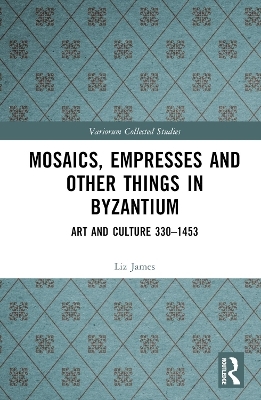
Mosaics, Empresses and Other Things in Byzantium
Routledge (Verlag)
978-1-032-61274-4 (ISBN)
The first section deals with light and colour and mosaics: four articles considering light and colour in mosaics and the making of mosaics, as well as the question of what it means to define mosaics as ‘Byzantine’ are reprinted. The second brings together four pieces on empresses: their relationships with female personifications and the Mother of God; their roles in founding and refounding buildings; and their employment as ciphers by some authors. Finally, seven papers cover a range of topics: what monumental images of saints in churches might have been for; what the differences between relics and icons might have been; how captions to images can be misleading; why touch was an important sense; how words can sometimes ‘just’ be decorative rather than for reading; why the materiality of objects makes a difference. There is also a brief section of additional notes and comments which add to, update and reflect on each piece now in 2024.
Mosaics, Empresses and Other Things in Byzantium will be of interest to scholars and students alike interested in material culture, the depiction of regal women, and the use of relics and icons in the Byzantine Empire.
Liz James is Professor of Art History at the University of Sussex. She is interested in all things to do with Byzantine art and especially, at the moment, mosaics. Her publications include Light and Colour in Byzantine Art (1996) and Empresses and Power in Early Byzantium (2001), as well as several edited books. Her most recent book is Mosaics in the Medieval World (2017), which contains some great pictures of mosaics.
Part 1 Light, Colour and Mosaics
1 What Colours Were Byzantine mosaics?
Medieval mosaics: light, color, materials, eds. E. Borsook, F. Superbi, G. Pagliarulo, (Harvard University Centre for Italian Renaissance Studies, Florence, 2000), 35–46
2 Mosaic Matters. Questions of Manufacturing and Mosaicists in the Mosaics of San Marco, Venice
San Marco, Byzantium and the myths of Venice, eds. H. Maguire and R. S. Nelson, (Dumbarton Oaks, Washington, D.C., 2010), 227–243
3 Made in Byzantium? Mosaics After 1204
Cross-cultural interaction between Byzantium and the West, 1204–1669, ed. A. Lymberopoulou, (Routledge, London, 2018), 258–271
4 Matters of Materiality in Byzantium: The Archangel Gabriel in Hagia Sophia, Constantinople
Konsthistorisk tidskrift/Journal of Art History 86, 3 (2017), special issue on Matter and Materiality in the Study of Medieval Art, ed. L.Liepe
Part 2 Empresses
5 Good Luck and Good Fortune to the Queen of Cities: Empresses and Tyches in Byzantium
Personification in the Greek world, eds. E. J. Stafford and J. Herrin, (Ashgate, Aldershot, 2005), 293–308
6 Making a Name: Reputation and Imperial Founding and Refounding in Constantinople
Female founders in Byzantium and beyond, eds. L. Theis, M. Mullett and M. Grünbart, Wiener Jahrbuch für Kunstgeschichte 60/61 (2011/12), 63–72
7 The Empress and the Virgin in Early Byzantium: Piety, Authority and Devotion
Images of the Mother of God, ed. M. Vassilaki, (Ashgate, Aldershot, 2005), 145–152
8 Ghosts in the Machine. The Lives and Deaths of Constantinian Imperial Women
Questions of gender in Byzantine society, eds. B. Neil and L. Garland, (Ashgate, Farnham, 2013), 93–112
Part 3 Materiality, Senses and Other Things
9 Monks, Monastic Art, the Sanctoral Cycle and the Middle Byzantine Church
The Theotokos Evergetis and eleventh-century monasticism, Belfast Byzantine Texts and Translations 6.1, eds. M. Mullett and A. Kirby, (Belfast Byzantine Texts and Translations, Belfast, 1994), 162–175.
10 Dry Bones and Painted Pictures: Relics and Icons in Byzantium
Eastern Christian relics, ed. A. Lidov, (Research Centre for Eastern Christian Culture, Moscow, 2002), 45–55
11 Art and Lies: Text, Image and Imagination in the Medieval World
Icon and word. The power of images in Byzantium, eds. A. Eastmond and L. James (Ashgate, Aldershot 2003), 59–72.
12 Seeing is Believing but Words Tell No Lies: Captions Versus Images in the Libri Carolini and Byzantine Iconoclasm
Negating the image: case studies in iconoclasm, eds. A. L. McClanan and J. Johnson, (Ashgate, Aldershot, 2005), 97–112
13 ‘And Shall These Mute Stones Speak?’ Text as Art
Art and text in Byzantium, ed. L. James, (Cambridge University Press, Cambridge, 2007), 188–206
14 Seeing’s Believing but Feeling’s the Truth: Touch and the Meaning of Byzantine Art
Images of the Byzantine world: visions, messages and meanings, ed. A. Lymberopoulou, (Ashgate, Farnham, 2011), 1–15
15 Things: Art and Experience in Byzantium
Experiencing Byzantium, eds. M. Jackson and C. Nesbitt, (Ashgate, Farnham, 2013), 17–34
Additional Notes and Comments
| Erscheinungsdatum | 10.07.2024 |
|---|---|
| Reihe/Serie | Variorum Collected Studies |
| Zusatzinfo | 17 Halftones, black and white; 17 Illustrations, black and white |
| Verlagsort | London |
| Sprache | englisch |
| Maße | 156 x 234 mm |
| Gewicht | 600 g |
| Themenwelt | Kunst / Musik / Theater ► Kunstgeschichte / Kunststile |
| Geisteswissenschaften ► Archäologie | |
| Geschichte ► Allgemeine Geschichte ► Vor- und Frühgeschichte | |
| Geschichte ► Allgemeine Geschichte ► Mittelalter | |
| ISBN-10 | 1-032-61274-6 / 1032612746 |
| ISBN-13 | 978-1-032-61274-4 / 9781032612744 |
| Zustand | Neuware |
| Informationen gemäß Produktsicherheitsverordnung (GPSR) | |
| Haben Sie eine Frage zum Produkt? |
aus dem Bereich


